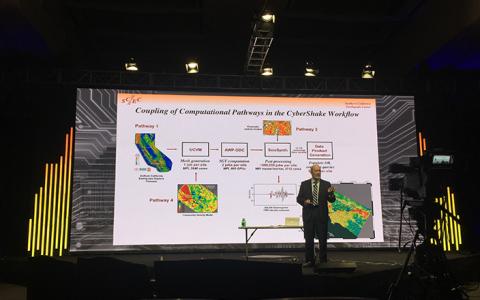SC15 Perspective from SCEC Research Programmer

As a SCEC software developer, I spend much of my time using high performance computing (HPC) to run the CyberShake project, which consists of large seismic hazard simulations on supercomputers. Therefore, I look for opportunities to improve my HPC knowledge and network with others also doing scientific research on supercomputers, and one of the best venues for this is the annual Supercomputing Conference (SC). This year's conference, SC15, was held in Austin, Texas from November 13-18, and welcomed almost 13,000 attendees to discuss anything and everything related to high performance computing.
SCEC's program of earthquake system science research includes a comprehensive suite of high performance computing software capable of running a variety of simulations, so SCEC researchers and collaborators frequently attend SC. I always find it valuable for staying up-to-date on the latest software and hardware trends, learning what other earthquake simulation groups are doing, and discovering tools and techniques for improving both my software development and my code performance. Additionally, I presented in the exhibit booth for USC's Center for High Performance Computing, explaining how we used USC's computing resources to coordinate a large series of CyberShake seismic hazard simulations across multiple supercomputers for over a month. Other SCEC researchers also presented their work, in posters, exhibit presentations, and talks.
SC consists of four main elements – tutorials, workshops, the technical program, and the exhibit floor. It can be a bit overwhelming: many tracks run concurrently during the technical program, the exhibit hall is 137,000 square feet and includes 343 academic and industry exhibitors, and then there are all the briefings and meetings that aren't part of the official program. However, its enormity is part of its appeal. Since it's the largest and highest-profile HPC conference in the U.S., practically everyone associated with large-scale computing attends. This includes staff from the NSF- and DoE-funded computing centers that SCEC heavily uses, such as the Texas Advanced Computing Center, the National Center for Supercomputing Applications, Argonne National Laboratory, and Oak Ridge National Laboratory, providing opportunities for us to brief them on the work of the past year and discuss our simulation plans for 2016. I consistently find these conversations to be the most valuable part of the conference.
On Thursday morning, SCEC Director Tom Jordan presented the plenary talk, “Societal Impact of Earthquake Simulations At Extreme Scale.” He discussed the broad impact SCEC has had, from the recent change to seismic safety standards in Los Angeles to the widespread success of the yearly ShakeOut drills. He then provided an overview of SCEC's complementary simulations, and showed visualizations from past and current SCEC simulations to the audience of several hundred. It was an excellent opportunity to present SCEC's cutting-edge HPC work to the larger community.
By the end of the six-day conference I was worn out from all the interactions, but also invigorated with new ideas and plans for the future. Next up for CyberShake is to migrate to UCERF3, the latest earthquake rupture forecast, which will require considering 25 times as many earthquakes. On to 2016!



